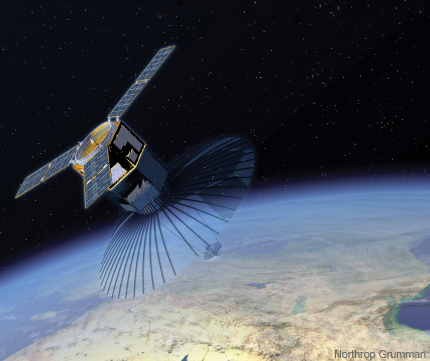Northrop’s Modular Space Vehicle gives Air Force faster satellite capability
The first open systems spacecraft bus will allow for ‘responsive space’ capabilities.
Northrop Grumman has delivered the first open systems spacecraft bus, which will allow military commanders to more quickly deploy satellites for specific missions.
The company’s plug-and-play Modular Space Vehicle (MSV) will give Air Force commanders the capability to quickly assemble satellites for immediate needs. MSV was built in 30 months under a $50 million contract, and was delivered to the Air Force’s Operationally Responsive Space Office (ORS), according to the Northrop announcement.
ORS’s mission is to plan and prepare the rapid deployment of effective space capabilities, according to its website. The MSV will be supporting this mission, enabling the launch of small, cheap satellites for short-term missions in a time span of only a few weeks -- a capability known as “responsive space.”

Artist’s concept shows the MSV in orbit.
MSV is a spacecraft bus, meaning that it is the general satellite model that can be equipped with different sensors and payloads. The open system nature of the vehicle allows for increased flexibility as modular payloads can be quickly and efficiently integrated, and has advantages such as:
- The use of common test equipment to check payloads prior to integration.
- A flexible power system that can be customized to have more or fewer batteries and solar arrays.
- The ability to accommodate last-minute payload and bus component changes without affecting costs and timing.
"Because MSV is the first to implement space plug-and-play standards with simplified, standard hardware and software interfaces, the bus is loaded with flexibility," said Doug Young, vice president of Missile Defense and Advanced Missions for Northrop Grumman Aerospace Systems.
MSV will be able to operate in Low Earth, Medium Earth, and Geosynchronous orbits and will support payloads for a range of missions such as radar imaging, missile warning, weather applications and military communications. It is expected to be able to orbit around the Earth for one to seven years.
MSV is capable of being launched from several vehicles, including the Minotaur I and IV, Evolved Expendable Launch Vehicles, and SpaceX’s Falcon 9, which recently has made moves toward the military market.
"MSV provides ways for future development of rapid response space capabilities that will be timely, cost-efficient and flexible," Young said. "A satellite bus contains the support structure and control subsystems that allow the payload to perform its mission."




